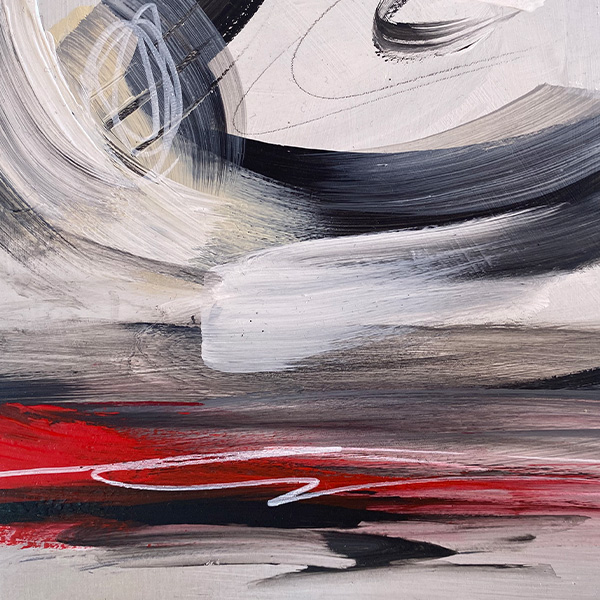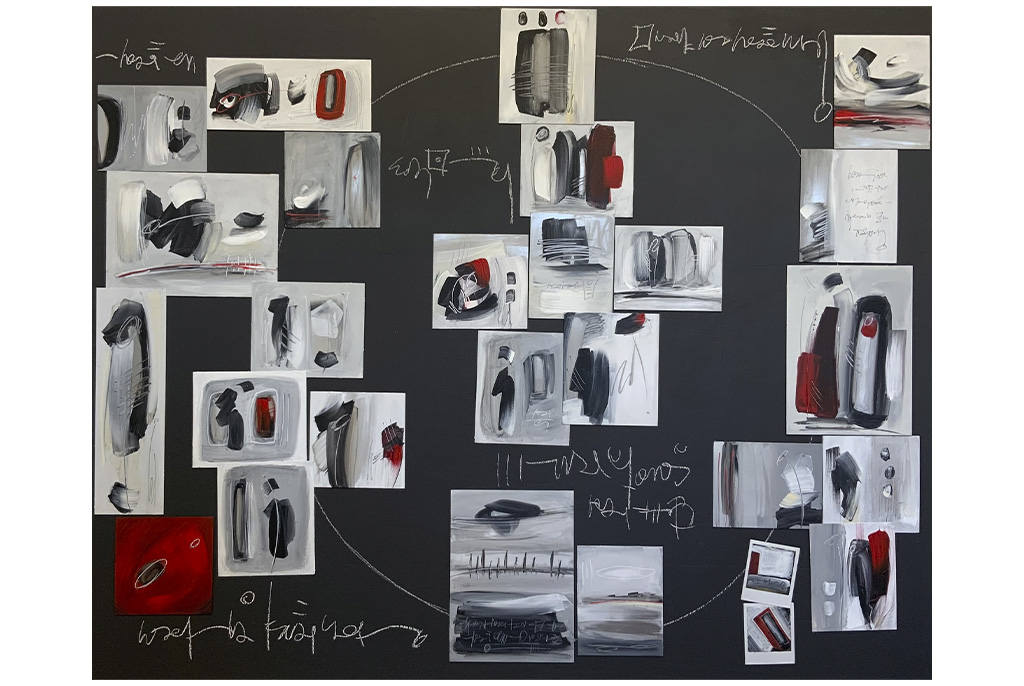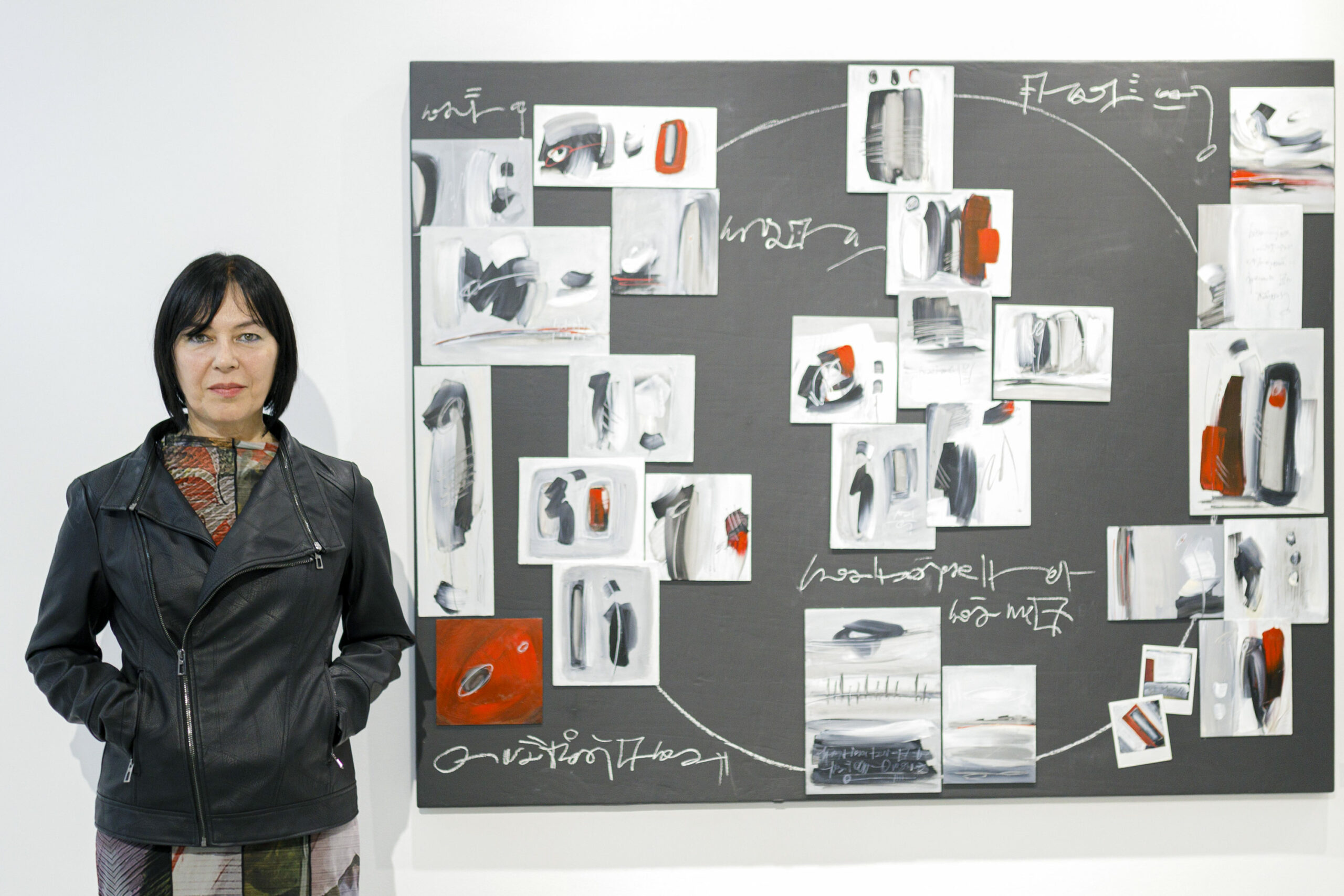
BIOGRAPHICAL NOTES
She was born in Bari in 1969, she attended art high school and later graduated as a cultural heritage worker. During her university studies, she participated, as a draftsman, in archaeological excavations in the Neolithic settlement of Polignano a Mare. This experience influenced her artistic research, characterized by the presence of fluid brushstrokes, gestures, and signs until giving birth to a very personal alphabet named Rosy, Sgrif, a kind of automatic and irrational writing made of ideograms and fast signs, which to this day constitutes a signature of the artist. She expresses herself through painting, installations, and performances. She lives and works between Latina and Bari.
ARTWORK IN CONTEST
Indizi II, 2024
PAINTING - Aluminium support treated with inserts of painted aluminium
150 x 120 x 2 cm
Rosy Losito composes her work Indizi II as a puzzle of interior stories, ‘memories’, which she writes and describes in finely abstract language. Chromatic traces, signs, and squares are exposed to multiple and possible aggregations in which the synthetic element is precisely the luminous character of the metal.
AWARDS
WINNER OF THE COMEL AUDIENCE AWARD 2024
With the following motivation:
Rosy Losito’s work establishes an intimate dialogue with the viewer, suggesting the existence of rich and complex inner worlds. Through subtle hints, the artist invites personal reflection, awakening deep and silent emotions.
by Dafne Crocella
In my artistic practice, abstract and real intertwine in a fluid, borderless dialogue. Form is not just a container; it is a bridge to abstraction, a language that translates emotions into visual experiences.
With your work Indizi II, you won the Audience Prize at the 11th edition of the Comel award. Did you expect this recognition? What do you feel your work communicated to the audience that chose it?
‘Indizi II’ represents a crucial chapter in my artistic journey and is part of a series started in 2010, entitled Indizi, in which many of the distinctive elements of my expressive language germinate. The series is a prelude to new experiences and experiments, including installations and performances in collaboration with other artists. This is why the award fills me with joy and I believe that behind the vote there is a curiosity on the part of the voting public, triggered by the complexity of the work. I would never have imagined finding myself among the finalists, let alone receiving an award, considering that this is my first adventure with aluminium.
The work, composed of a set of painted aluminium inserts, is entitled Clues II, what are you referring to when you talk about clues? Is it a series of which this work is the second element?
In the ‘Clues’ series of which this work is a part, the basic idea is to create interactive works in which the viewer can play an active role in the life of the work itself. The modules that make up the works are magnetic; they can be moved and rearranged on the surface, which is also magnetic, creating new compositions and meanings. Every change, every shift, every combination brings with it a new narrative, a new clue to a new story to be told. Every time the arrangement of the modules is changed, a new composition is created, expanding the creative possibilities. The use of aluminium as the main material in this latest version of the work adds a further layer of meaning. Aluminium is a versatile and resilient material, symbolising the ability to adapt and transform, it also has a reflective surface reminiscent of a mirror in which to be reflected.
This year's edition of the Comel Award is entitled Beneath the surface and invites artists to confront what lives below, of appearances, attitudes, surfaces. Was this theme an inspiration for you? How did you approach it in your work?
It was the theme of this edition of the Comel Award that aroused in me the desire to participate, a theme that particularly touches me. ‘Indizi II’ is a reflection on the intimacy and complexity of the human soul. Beyond the appearances, beneath the sheen of standardised existences, lies a universe of inner worlds, layered and vibrant, often overlooked or ignored. These worlds contain the unexplored potential of our lives, a fertile ground of experiences and emotions. In this work, I emphasise through signs and clues that infinite creative landscape that inhabits us. These signs, although invisible, are witnesses to a palpable reality, ready to be discovered and contemplated.
In the winning work, we find a series of graphic gestures that you came to mark on the surface of the dark slab directly in the gallery. It is a kind of personal writing of yours. What does it represent? What is the origin of this graphic gesture?
The writing in many of my works is so important that I have given it a name: Sgrif, as I coined it in 2008. This onomatopoeic term evokes the sound of chalk on a blackboard. Sgrif is meaningless writing, the result of an evolutionary process in which signs and scratches intertwine, giving rise to a free and ever-changing language. Through Sgrif I explore a playful and primordial dimension, a return to the origins that connects me to my childhood world, a way to keep my most authentic creativity alive.
We often find this graphic gesture in your work. It is an ancient expression that accompanies you. When did you start using it? And what do you feel it continues to communicate?
There is a vivid memory in my memory, of me as a child in primary school, when I still could not read and write. The teacher, with her large hands, was tracing marks on the blackboard, a large space that seemed endless to me, incomprehensible to me. With white chalk she wrote, creating figures and shapes that my childlike imagination transformed into mysterious worlds. I was enraptured, enchanted by that magic, lost in my thoughts as I imagined that each mark was a step towards a secret universe. Then, suddenly, my gaze rested on and deciphered a word: ‘butterfly’. That word revealed itself in all its beauty, but with it came a conflicting emotion. The moment I understood the meaning, an overwhelming joy pervaded me, but it was immediately followed by a veil of disenchantment. I realised that this magical dimension, with its floating signs, was nothing more than a game of my childish mind. I realised that this magical dimension, with its floating signs, was nothing more than a game of my childish mind. And so, in that instant, I entered the adult world, where wonder faded and reality showed itself for what it was. Nevertheless, the memory of that day has remained engraved in my memory, a deep connection to my childish side, a connection to a time when anything was possible, this experience originated my free writing, the Sgrif.
Your creative research is characterised by works with dense brushstrokes that arise from informal instinctive gestures. To these brushstrokes you then add small marks that seem to suggest recognisable forms, narratives, perhaps people or landscapes. What is the relationship in your art between form and abstraction?
In my artistic practice, abstract and real intertwine in a fluid, borderless dialogue. Form is not just a container; it is a bridge to abstraction, a language that translates emotions into visual experiences. Lines merge with fields of colour, creating a complex fabric where abstraction does not deny the real, but reinterprets it, inviting us to unveil hidden meanings. I am not interested in confining my art into rigid categories; rather, I explore the nuances of an interaction that transcends representation, revealing the richness of multiple interpretations. Thus, form and abstraction coexist in a continuous creative tension.
In several of your works we find a minimalist colour choice: black and white, with greys, and then a few touches of red. Where does this choice come from? What significance do you give to the red stroke in your work?
I often use black and white in my work, a duality that evokes the purity of the idea, of the draft, White for me represents unexpressed potential, while black embodies the intensity of thought, the absence of other colours paradoxically becomes presence, creating a space of contemplative silence. This choice of colour is not just an aesthetic preference, but an invitation to reflect on what is visible and what remains in the shadows, on the creative process that precedes the completed work. The inclusion of red, a colour that bursts in with its force, becomes a moment of rupture, a stroke of vitality that captures the attention and invites one to pause. It is a colour that does not merely decorate, but provokes, questions and forces one to reconsider the narrative flow. Red is not just a visual element, but an emotional reminder, a beat that interrupts the linearity of reading and invites a deeper sensory experience.
Your works communicate a sense of depth and at the same time of suspension, of immediacy and thoughtful reflection, they seem to move in a delicate balance between opposites as if they were born from meditative moments from which traits emerge that suggest without forcing. How do your works originate? Do you feel more gestural and instinctive or tied to reasoning?
My works arise from a creative process in which gestures and reflection intertwine in a continuous dialogue between sign and silence, between the immediacy of the act and the reflection that follows. Evoking a sense of temporal suspension, I reflect on the flow of time. In this space of waiting, the present becomes palpable, the material is transformed, revealing the ephemeral essence of human experience, suspended between the instant and eternity. I never feel completely immersed in a single dimension; instinct is constantly confronted with critical thinking. Each work is an attempt to translate that fragile and dynamic balance, to explore the tensions and harmonies that emerge from this creative process. I use broad brushstrokes of colour that are rarely mixed with others, sometimes they are covered by consecutive layers of veiling, they are marks that have a value, a uniqueness of their own, a declaration of presence that evokes the essence of places and memories. I am very involved in designing and working, I focus on a result that satisfies me, my artistic production is linked to this
Are there artists from the past to whom you feel particularly attached and who do you feel have influenced your work in some way?
When I was young, I was attracted to Byzantine painting and Flemish art, I studied the painting of Cézanne, particularly in his later period. Rothko captured my attention with his colour fields, which evoke almost otherworldly atmospheres I also delved into the work of artists such as Mathieu, Wols and Hartung, who were able to canalise the energy of gesture through a sign language. Kiefer, Afro, Burri and many other artists continue to be a source of great interest and inspiration.






